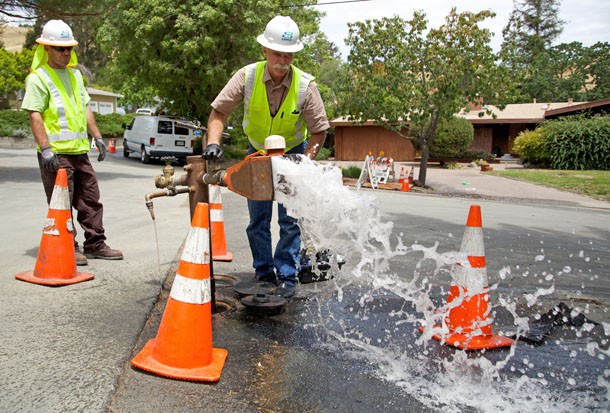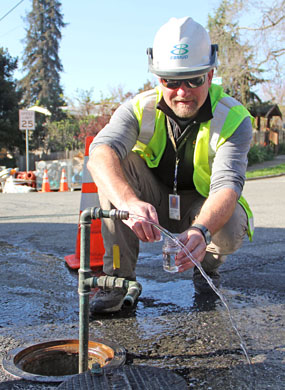
EBMUD flushes pipes to remove sediment and discolored water following a repair or new pipe installation. Flushing is necessary to keep your water safe.
When does EBMUD perform flushing?
After pipe installations or repairs, EBMUD crews may flush the lines with large quantities of water to ensure water is clean and safe. When crews flush pipes, customers may see large volumes of water discharged into tanks or storm drains. Flushing is a critical step to keep your water safe by removing sediment and discolored water following a repair or new pipe installation.
This operational practice also provides an opportunity to identify broken or inoperable valves and hydrants which is important to ensure that they will work properly in the future.
How does flushing clean pipes?
During the flushing process, water is forced through the water main at a high speed and discharged through hydrants. The fast-moving water scours and cleans by removing sediment and discolored water that may be in the pipe.
What does EBMUD do to protect the environment when flushing?
- EBMUD neutralizes chloraminated water before it enters storm drains to prevent impacts to aquatic life or habitats.
- Gravel bags and filter mats are used to reduce sediment in the flushed water before it enters the storm drain.
Can you reuse the water?
EBMUD values conservation and water reuse, especially in times of drought, and works to reuse flushed water when possible by capturing the flushed water and reusing it to irrigate school playing fields, public grounds or our watershed lands.

Water quality inspectors collect water samples, which are analyzed to make sure they meet the highest standards.
How does EBMUD check water quality?
Water quality inspectors collect samples at the worksite after a pipe is flushed and before it is placed in service, as required by the State Water Resources Control Board. Flushing and follow-up sampling help ensure our drinking water meets or surpasses all state and federal regulatory requirements.
What should customers do?
When repairs are made in your neighborhood, you may want to flush your home faucets as well. Once water service is restored, turn on your front hose bib – the outdoor faucet at the front of the house – until the water runs clear. Also run cold water from the faucets inside your home for 1-3 minutes until clear.